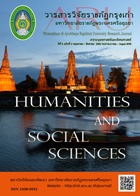หมู่อาคารโบราณมรดกโลก อู่ตังซาน (武当山): เครือข่ายและอิทธิพลของศาสนาเต๋าต่องานเผยแพร่วัฒนธรรมจีน
Main Article Content
บทคัดย่อ
หมู่อาคารโบราณอู่ตังซานอาจสะท้อนภาพความความสัมพันธ์ระหว่างการเมืองและศาสนาที่ใครหลายคนอาจเข้าใจว่าศาสนาเป็นเรื่องต้องห้ามในสังคมจีน แต่ด้วยนโยบายการเผยแพร่วัฒนธรรมจีนในปัจจุบันนั้นยอมรับและเปิดโอกาสให้หลายศาสนารวมทั้งศาสนาเต๋าสามารถเผยแพร่คำสอนได้อย่างกว้างขว้างมากขึ้น หลังจากที่ได้รับการบูรณะและขึ้นทะเบียนเป็นมรดกโลกแล้ว หมู่อาคารโบราณอู่ตังซานได้กลับมาเป็นศูนย์กลางของศาสนาเต๋า ศาสนาที่มีต้นกำเนิดบนแผ่นดินจีนอีกครั้งด้วยการสร้างเครือข่ายต่างๆในระดับองค์กรภายในและภายนอกประเทศ รวมทั้งการส่งเสริมการท่องเที่ยวเพื่อรองรับการขยายตัวทางเศรษฐกิจของหน่วยงานรัฐบาล ในบทความนี้ได้สรุปสาระของการสร้างและบูรณะหมู่อาคารภายใต้ความเชื่อในเทพเจ้าทิศเหนือ การจัดการพื้นที่ของหน่วยงานภาครัฐบาลท้องถิ่นและองค์กรศาสนาเต๋าในพื้นที่ภูเขาอู่ตังซานรวมทั้งการขยายความร่วมมือระดับนานาชาติ ตลอดจนการต่อยอดในการท่องเที่ยวและการรับรองคุณภาพผลิตภัณฑ์ต่างๆภายใต้ตรารับประกันอู่ตังซาน จนกลายเป็นเอกลักษณ์เฉพาะในแหล่งมรดกโลกตัวแทนทางวัฒนธรรมจีนแห่งนี้เท่านั้น
Article Details
อยู่ระหว่างการปรับปรุง (ลิขสิทธิ์และการรับผิดชอบ)
เอกสารอ้างอิง
UNESCO. Ancient Building Complex in the Wudang Mountains. World Heritage Convention [World Heritage Center ] 2016 [cited 2018; Available from: http://whc.unesco.org.
Karetzky, P.E., The Transformations of Xuanwu/Zhenwu. Journal of Daoist Studies, 2015. 8(8): p. 69-95.
Lagerwey, J., The Pilgrimage to Wu-tang shan. Pilgrims and sacred sites in China, 1992: p. 293-332.
Zhu, S. and Y. Ding, The Secret Backdrop of Chinese Cultural Heritage Sites-A Case of Ancient Building Complexes on Wudang Mountain. 2008.
De Bernardi, J., Wudang Mountain and the Modernization of Daoism. Journal of Daoist Studies, 2009. 3(3): p. 202-210.
Rattanakul, S., Eastern civilization: China II. 2004: College of Religious Studies, Mahidol University.
Hu, G., X. Zhu, and Z. Zhou, Discussion on the Taoist Culture and the Tourist Resources of Wudang Mountain [J]. Journal of Chongqing Institute of Technology, 2006. 6: p. 027.
De Bernardi, J., On Daoism and Religious Networks in a Digital Age, in Place/No-Place in Urban Asian Religiosity. 2016, Springer. p. 91-108.
Chi-Tim, L., Daoism in China today, 1980–2002. The China Quarterly, 2003. 174: p. 413-427.
De Bernardi, J. and Z. Weibin, Wudang Daoist Tea Culture. Re-orienting Cuisine: East Asian Foodways in the Twenty-First Century, 2015. 3: p. 56.
Liang, W. and J. Yuanbo, Shiyan promotes development of tea industry, in ChinaDaily. 2015, ChinaDaily: China.
Weiliang, Z., A Cultural Case under the Influence of Wudang Taoist Culture: A Historical Combing Based on Wudang Wushu. Chinese Wushu (Research), 2013. 1: p. 002.
Hanban News, 2018 Chinese New Year Wushu Culture Festival and International Chinese Wushu Invitational Tournament Held at Belarusian State University of Physical Education, in HanBan News. 2018, Hanban News: China.
Zhenxiong, W., Tai Chi and Martial Arts Team of Confucius Institute at University of Sierra Leone Shines at the Commencement Ceremony of Sierra Leone’s Port of Freetown QE II Quay and Draws Praise from Sierra Leonean President, in Hanban News. 2018, Hanban News: China.
Loannis, P., Defining and managing ‘living heritage’, in Past in the Present: A Living Heritage Approach. 2014, Meteora Ubiquity: Greece.
UNESCO, Report on the WHC-ICOMOS-ICCROM Joint Reactive Monitoring Mission to the Ancient Building Complex in the Wudang Moutain, in C705. 2014.
Warasiriphong, C., Cultural Resource Management of the Jingdezhen Ceramics Industry: A Study of Jiangxi Province, People’s Republic of China. Journal of Mekong Societies, 2015. 11(1): p. 151-174.
Lertchanrit, T., Cultural Resource Management. 2011, Bangkok: Princess Maha Chakri Sirindhorn Anthropology Centre.
Sritharet, P., Thai-Chinese Social and Cultural Capital for Promoting Religious and Cultural Tourism in Ubon Ratchathani Province. Humanities and Social Sciences Journal Ubonratchathani Rajabhat University, 2017. 8(1): p. 212-230.
Praicharnjit, S., Archaeological Resource Management in Community Development. 2007, Bangkok: Community Archeology Book Project. p. 440.
Xinhua, Fire Damages Ancient Palace in Hubei, in Xinhua News Agency. 2003, China Internet Information Center: China.
ChinaDaily, Saving ancient UNESCO heritage in China, in China Daily. 2012: China.
Glenday, C., Guinness world records 2015. 2015: Bantam.
Nonaka, I., The knowledge-creating company. 2008: Harvard Business Review Press.
Zhang, W., Tourism management model for World Heritage Sites situated cities. Beijing: Peking University, 2002.
Li, M., B. Wu, and L. Cai, Tourism development of World Heritage Sites in China: A geographic perspective. Tourism Management, 2008. 29(2): p. 308-319.
Zhu, X., Sustainable tourism development: A case study in Mount Wudang. Market Modernization, 2005: p. 207-209.
Xiangling, K., et al., Project Design of Tourism E-commerce System for Wudang Mountain Based on CRM [J]. Journal of Hubei Automotive Industries Institute, 2011. 2: p. 017.
Gui, G., Should China Now Lead UNESCO?
The move would represent a step in the wrong direction for the organization., in The Diplomat. 2017.
Bland, B. and W. Xueqiao, High cost of China’s push for Unesco heritage sites, in Gulangyu. 2017, China Society: China.
Moncloa, L., Spain and China sign Memorandum of Understanding (MoU) on cultural heritage, in Gobierno De Espana. 2015: Spain.
An, China, Serbia sign MOU on cultural heritage protection cooperation, in Xinhuanet. 2017, Xinhuanet: China.
Maspero, H., Taoism and Chinese Religious. 2015, Melbourne & Basel: Quirin.
Xinqi, R., The 4th International Taoism Forum to be held at Wudang Mountain in May, in Hubei.gov.cn. 2017, Hubei.gov.cn: China.
Wudangtaosim. Explore: Taoism, Chinese Martial Arts, Taoist Medicine, Tai Chi, Qi Gong, Kung Fu, Internal Alchemy, Taoist Scriptures and Ceremony. 2017 [cited 2018 February 18 ]; Available from: http://fiveimmortals.com/.
Linyong, Z., The Way to Wudang, in ChinaDaily. 2010, ChinaDaily: China.


